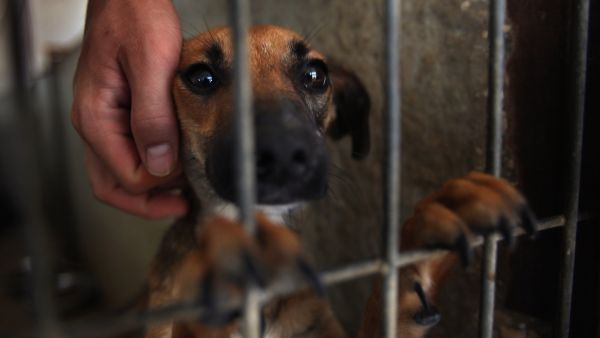“After a walk in the local park, my dog began foaming at the mouth and shaking. I remembered that he had run towards something that had taken his interest in the park, and realized he had ingested poison,” recalls a French expatriate. “His legs were dragging on the way home and for once he was not pulling on the leash, but I did not realize what was wrong. By the time we realized it was too late, but there is no emergency animal hospital here so there was nothing I could do but watch him die,” she added. “Whether you are an animal lover or not, watching an animal die like that is awful. No one would impose that on any living thing if they saw how the animal dies after ingesting it.”
After her dog was killed by the poisoned food, she contacted the Public Authority for Agriculture Affairs and Fish Resources (PAAAFR), but she said they refused to meet her or to send someone to investigate the problem. Still searching for answers, she sent a sample of the poisoned pellets abroad and said that the poison used is a controlled substance in Kuwait, and therefore cannot be imported freely by anyone. “This shows a lack of responsibility and a lack of forward thinking. There are specialists to address problems; they cannot be randomly dealt with in a haphazard manner,” she said. The PAAAFR was unreachable for comment when contacted by Kuwait Times yesterday.
The scattering of poisoned food in an attempt to ‘manage’ the increasing numbers of stray dogs is, apparently, nothing new. Pet owners and animal activists have been trying to address the issue and call for change but, as of yet, they say the practice is still continuing. “I noticed five large, stray dogs in Shuwaikh park, so I called the PAAAFR to bring the issue to their attention because strays were sometimes coming after my dog, who is tiny,” said pet owner Shaikha Al-Khaldi.
While Khaldi was not surprised by the sight of the strays, she was shocked when she learnt of their fate. “I thought they would come and collect the dogs, as pounds usually do. When I called, however, they told me that they would come and place poison in the park to ‘fix’ the problem.” Khaldi added, “I was horrified, and when I pointed out that it is inhumane to poison the strays, they completely shrugged off the comment.” Worried about the risk of her pet eating the contaminated food, she highlighted how dangerous scattering poisoned food is. “I argued that it would not be safe for dogs to roam freely in the park anymore, but he simply told me that the poison was placed by the outer gates, and that if I was concerned, I should stop taking my dog there.” Despite her fears, Shaikha continues to take her dog to the park, but keep him on a leash. “I noticed that the strays were gone, and saw dog food scattered around the park. I called back and asked if poison had been placed in the park, and they said yes. The poison was in the middle of the park; any dog could eat it.”
John Peaveler, Managing Director at the Kuwait Society for the Protection of Animals and their Habitat (K’S PATH) said of the practice: “It’s been going on for years. The PAAAAFR contract the work out. But, from a population management standpoint, it’s not effective. Reactive population control does nothing. The population of strays is only increasing: every time you knock out a small number of animals, you are actually making the problem worse because more offspring survive to later compete for resources. Population control does not work in small quantities.”
It is effective, however, in sparking fear in pet owners as their pets try and feast on the seemingly innocent food. “I cannot let my dog run freely around the park anymore because of this. I caught him eating a pellet of poisoned food, and luckily it was not enough to harm him,” said Khaldi. “Since they are unwilling to stop placing poison in the parks, I asked that they at least put up signs to warn pet owners. They even refused that, insisting that it would be too much effort to place a sign every time they planted poison.” Unknowing pet owners have suffered the consequences as a result. “My friend’s dog ate the poisoned food and died because of it. It’s not even humane euthanasia: the dog died over the period of an hour, foaming at the mouth. It is a slow, painful death.”
However, despite many losing their pets as a result of the poisoned food, no action has been taken, “There are many cases of pets dying as a result of this, but there is no accountability,” said Peaveler. “Poisoning strays is extremely inhumane. It can take anywhere from 20 minutes to 20 hours depending on how much poison they ingested, the size of the animal etc. It is exceptionally painful.”
The situation of animals in Kuwait is already pretty grim given that, according to Peaveler, there is a high rate of intentional animal cruelty. “The mortality rate of puppies in Kuwait is 90 percent, so only 10 percent will ever see adulthood, and the average life expectancy for dogs is only one and a half to two years. A normal street dog should reach around 6 years of age,” he said.
Khaldi commented that the issue of animal cruelty is belittled because it’s ‘just a dog’, adding, “This kind of thinking only further supports the inhumane treatment of strays, and risks now threatening pets. Even if they do not care about animals, what about toddlers and children that go to parks? They pick up random objects all the time, and it is somehow appropriate to have poison lying around.” Peaveler added: “Even if there is little regard for the inhumane element, it is still not an effective means of controlling a stray animal population. It is inefficient, and it is indiscriminate. There must be a population management strategy.”
Humane population management strategies have proven successful in Kuwait, as K’S PATH managed to implement a successful plan in Ahmadi. “We were contacted by Kuwait Oil Company, who wanted a humane and effective method for animal control. We surveyed the area and estimated that there were between 400 to 800 strays, who were causing many problems in the area,” said Peaveler. “There are three ways to manage strays once they are found. They can be sterilized, vaccinated, and re-released if in a non-residential area. Friendly dogs can be sent to the shelter and evaluated to see if they are eligible for adoption.”
Euthanasia remains an option in bringing large populations of strays under control, but there is a vast difference between poisoning and humane euthanasia, Peaveler added. “The final option is humane euthanasia. Sometimes we’ve found over 50 dogs at just one site. Such numbers make sheltering impractical, especially if you consider that most of these animals are not pets.”
However, bringing stray populations under control paves the way for a better future for the animals. “Now every dog found in Ahmadi can be taken to the shelter because the population is under control: we are down to just three of the original dogs found a year ago in the area and have caught over 600,” Peaveler stated. “The animal control teams monitor the site to keep everything under control, and complaints regarding strays have dropped from dozens a day to maybe one a month.”
By Lisa Conrad








